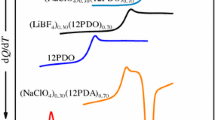Abstract
The glass transition of isomalt and its components, the enthalpy of solution (crystalline state, glassy state) and the enthalpy of melting are reported. From the measured data (solution enthalpy, enthalpy of fusion and heat capacities) a cycle like the BORN-HABER cycle can be constructed. It is possible to calculate the amounts of amorphous isomalt from measured solution enthalpies; however, the values obtained do not agree with those provided by X-ray powder diffraction studies.
Similar content being viewed by others
Explore related subjects
Discover the latest articles, news and stories from top researchers in related subjects.References
H. K. Cammenga and B. Zielasko, Thermochim. Acta, in press.
Deutsches Institut für Normung e. V. (1994): DIN 51007 — Differenzthermoanalyse (DTA), Beuth Verlag, Berlin.
A. Raemy and T. F. Schweizer, J. Thermal Anal., 28 (1983) 95.
M. H. Pikal, A. L. Lukes and J. E. Lang, J. Pharm. Sci., 67 (1978) 767.
Author information
Authors and Affiliations
Additional information
This study was supported by Südzucker AG, Mannheim/Ochsenfurt. We thank Dr. M. Kunz and G. Witte of Südzucker AG for discussions.
Rights and permissions
About this article
Cite this article
Cammenga, H.K., Figura, L.O. & Zielasko, B. Thermal behaviour of some sugar alcohols. Journal of Thermal Analysis 47, 427–434 (1996). https://doi.org/10.1007/BF01983984
Issue Date:
DOI: https://doi.org/10.1007/BF01983984




